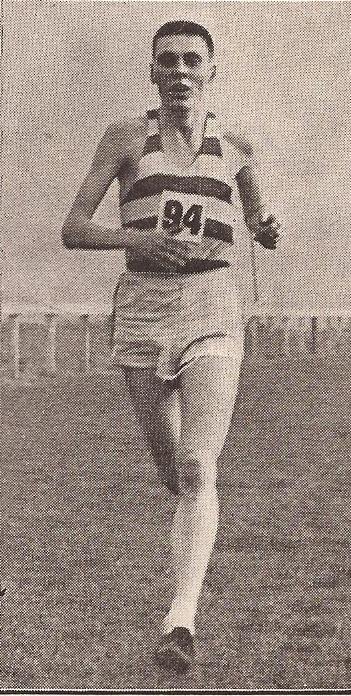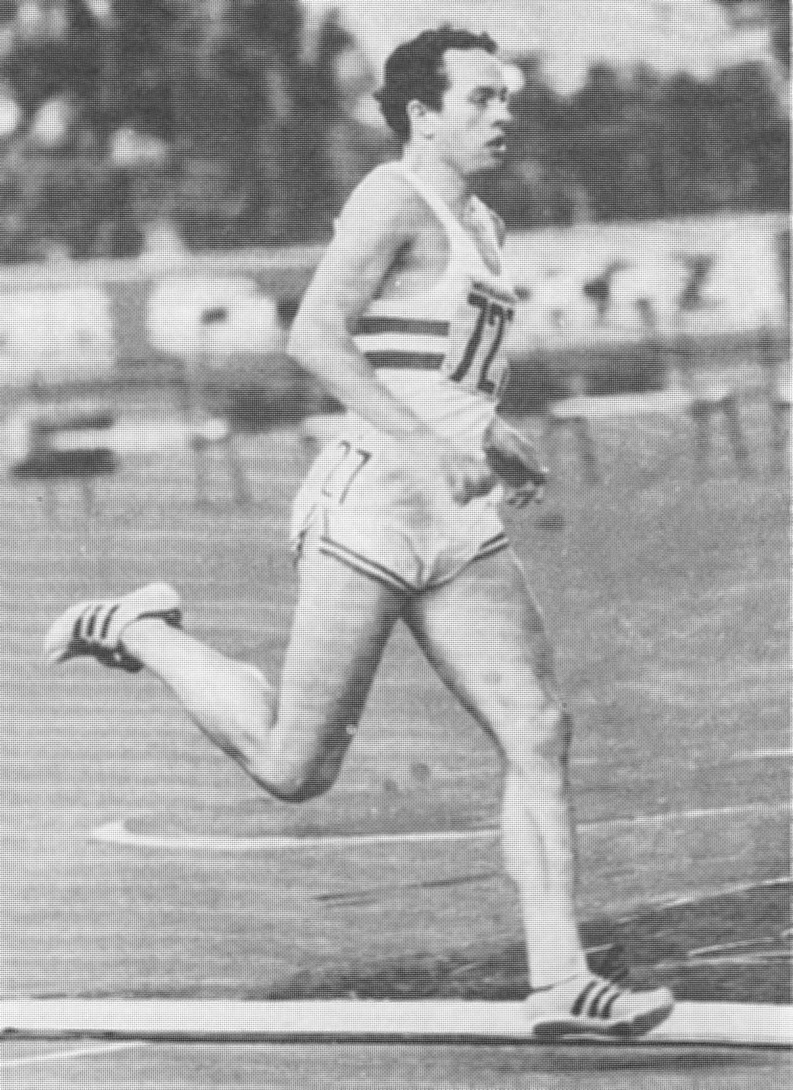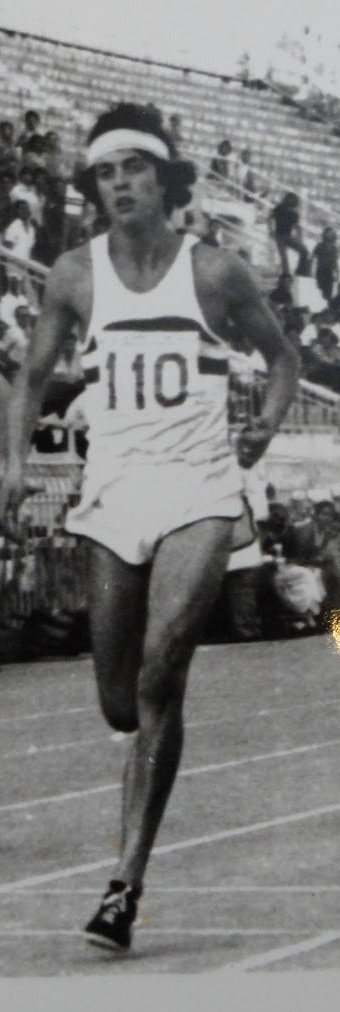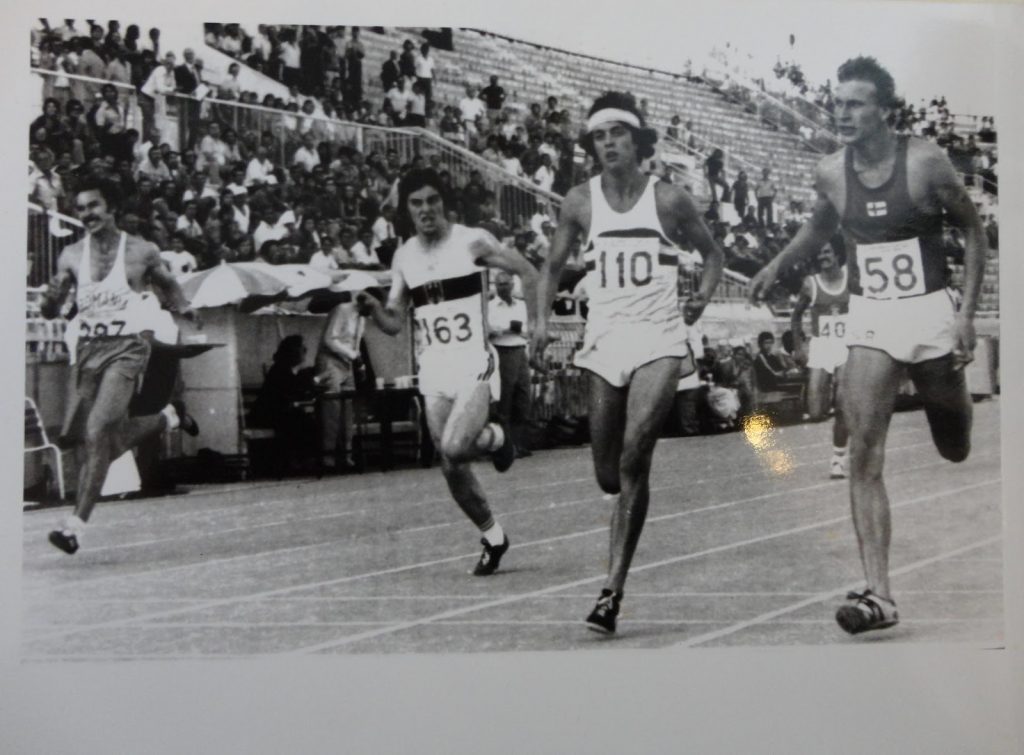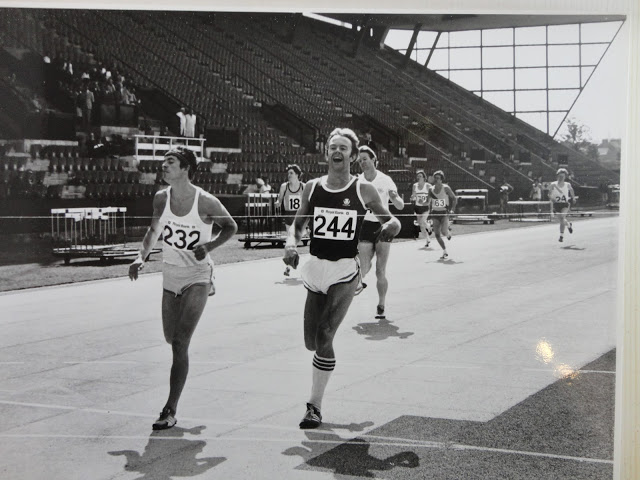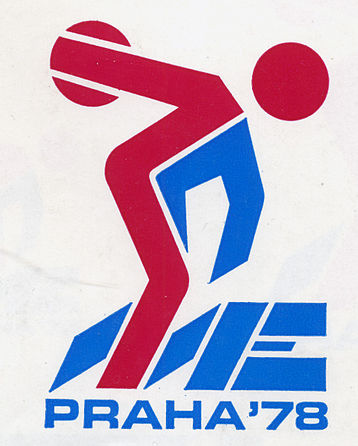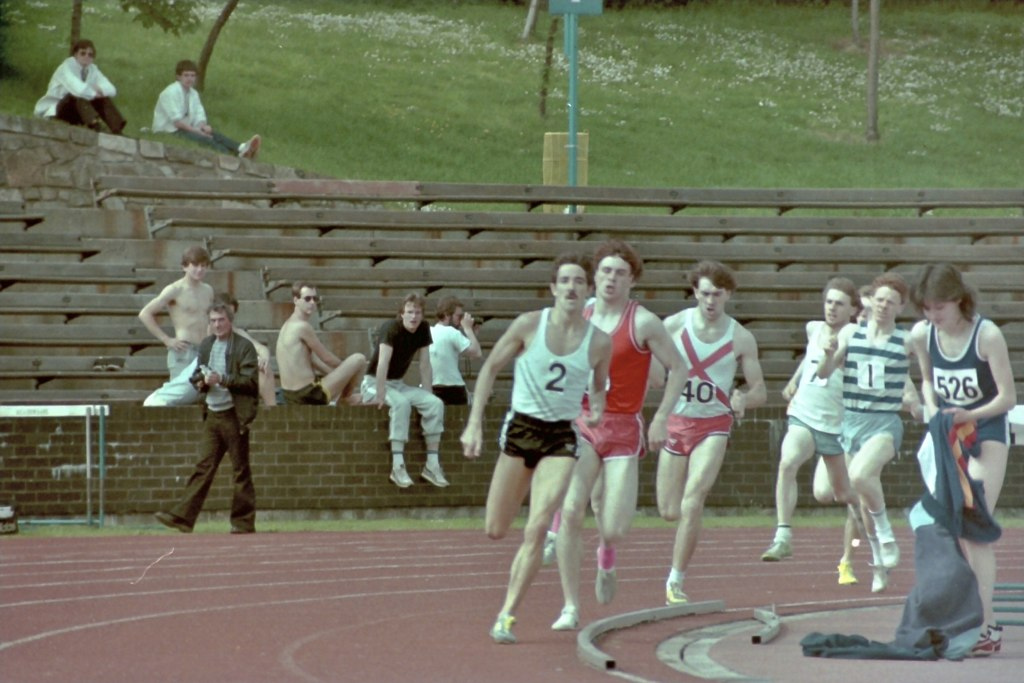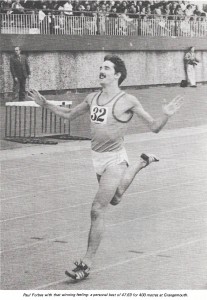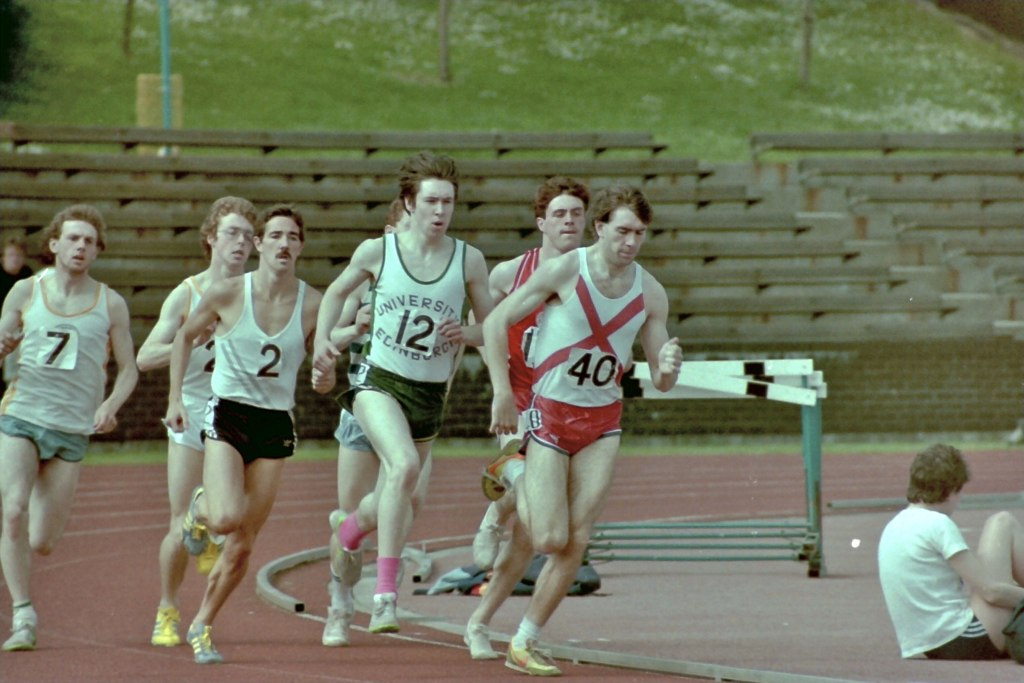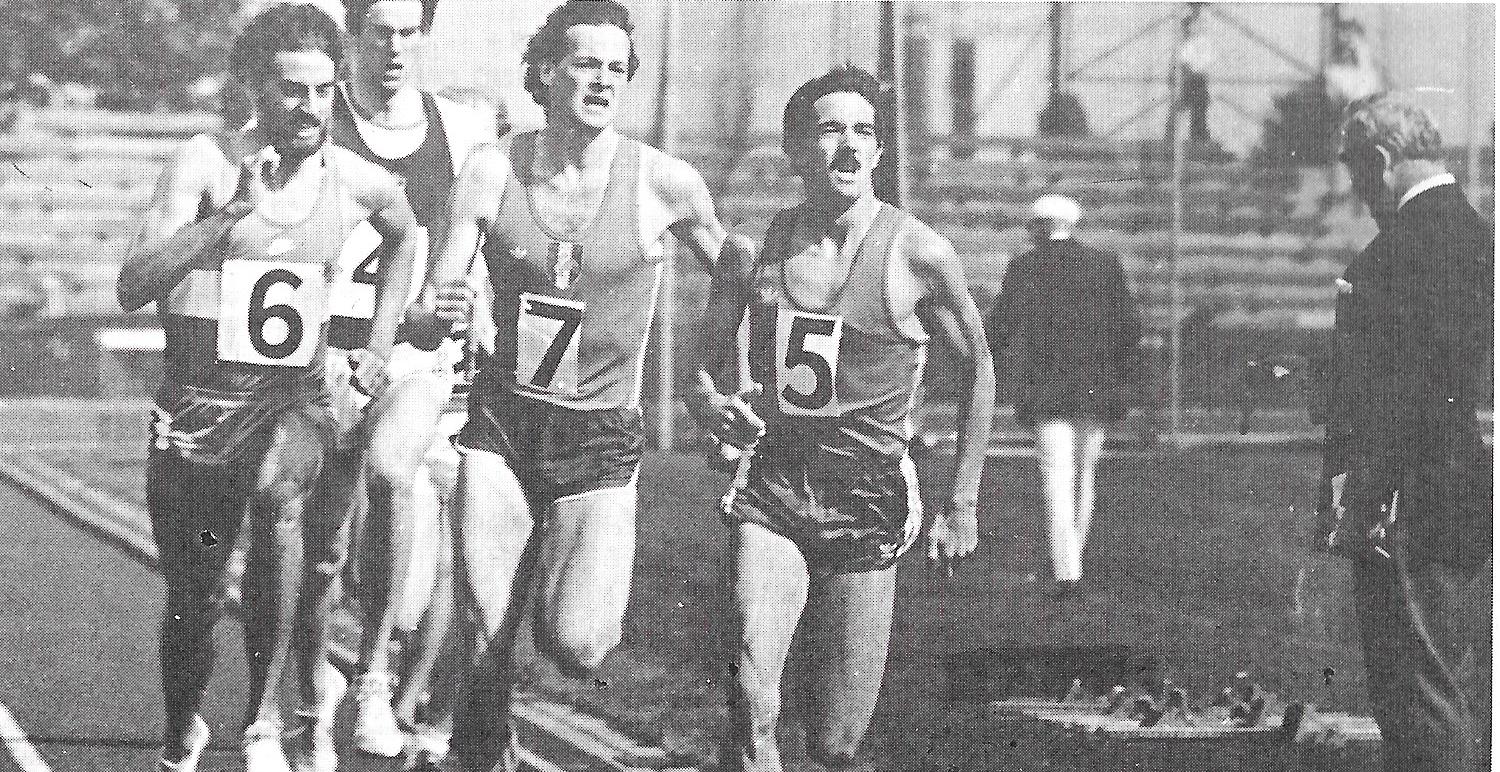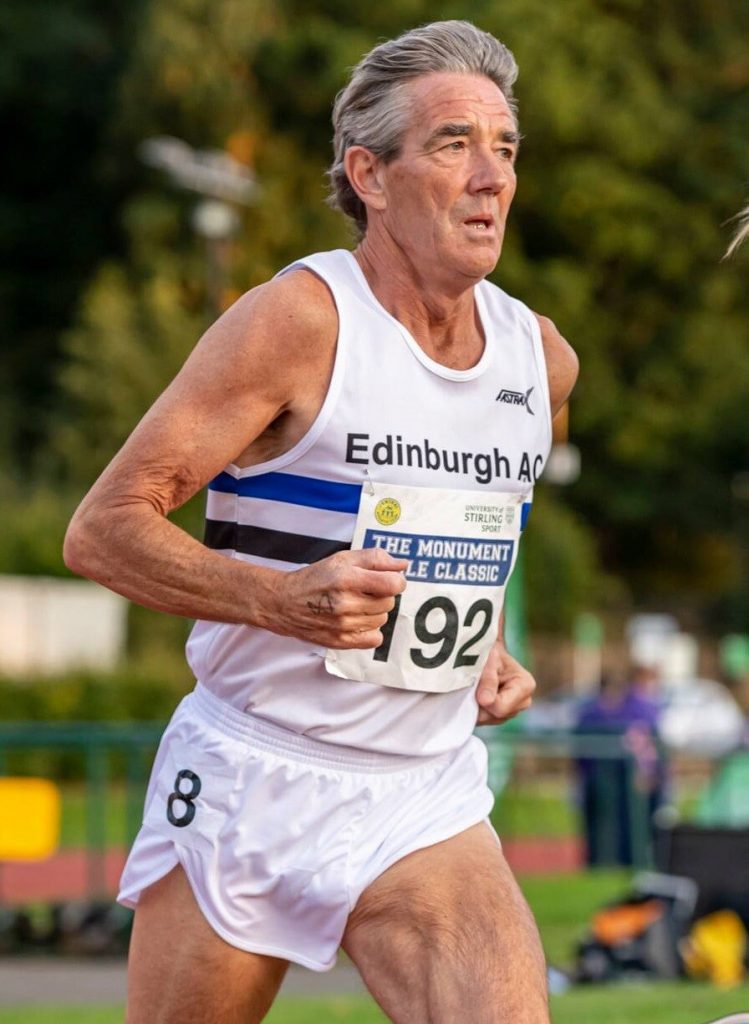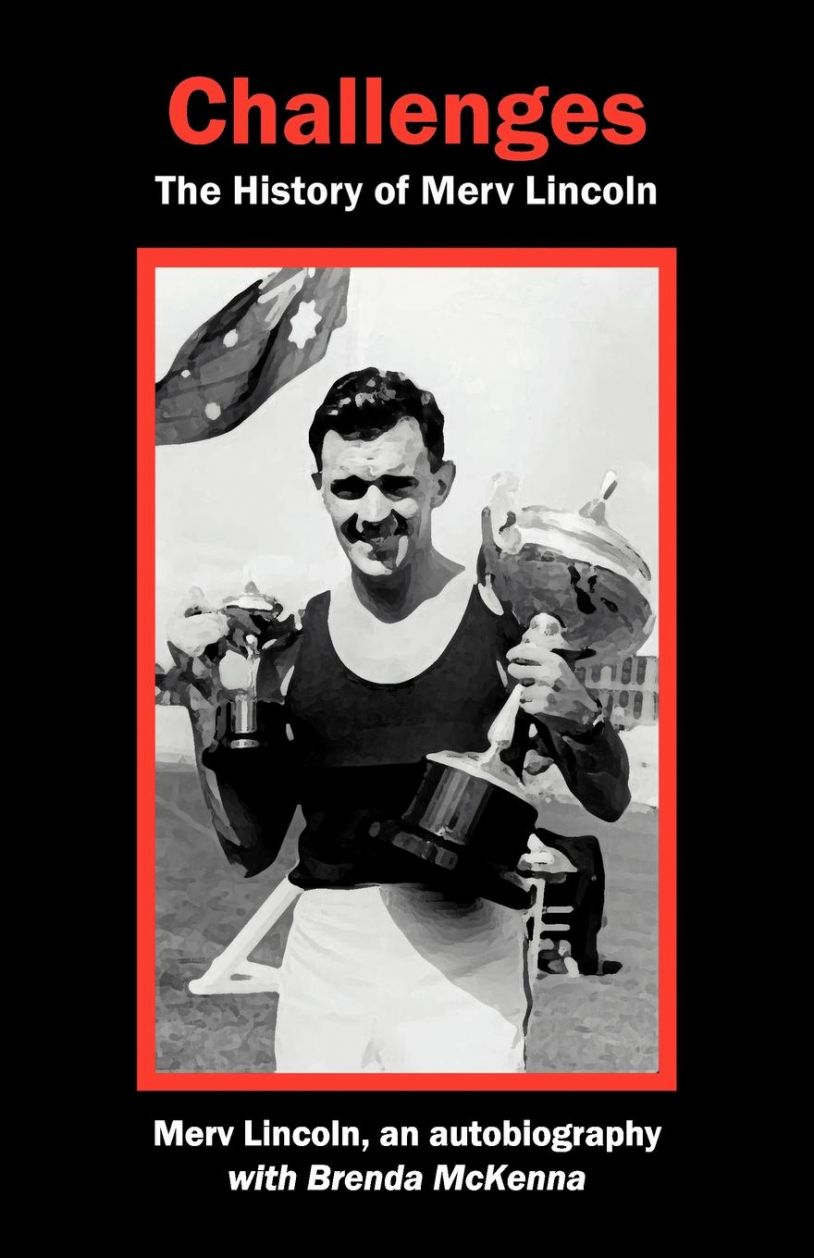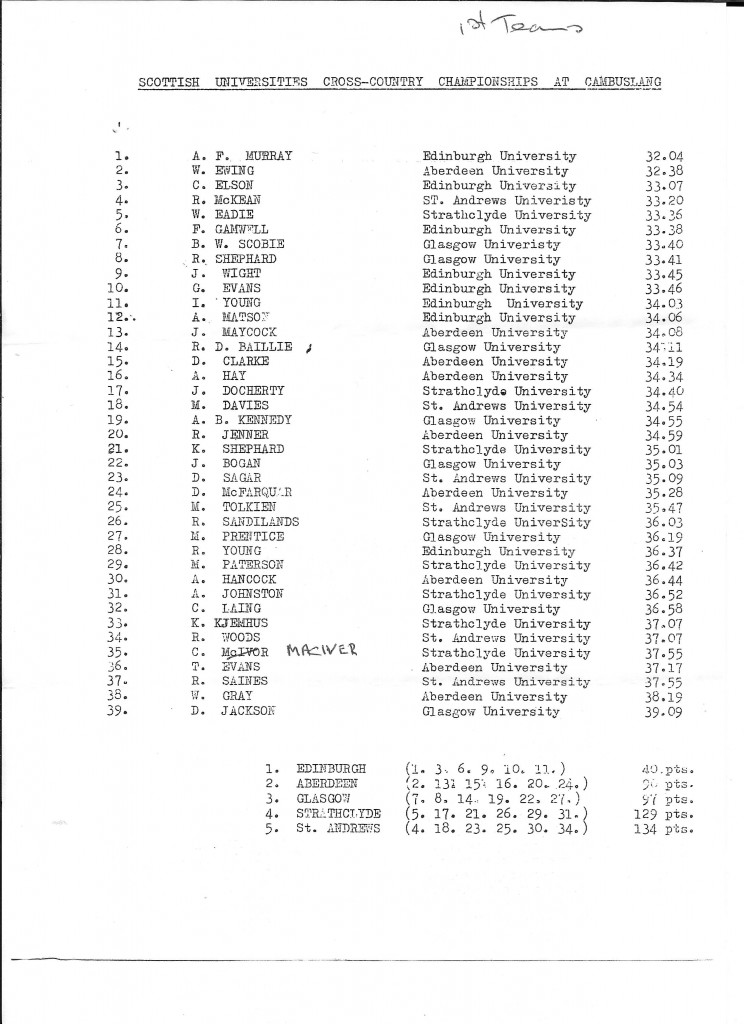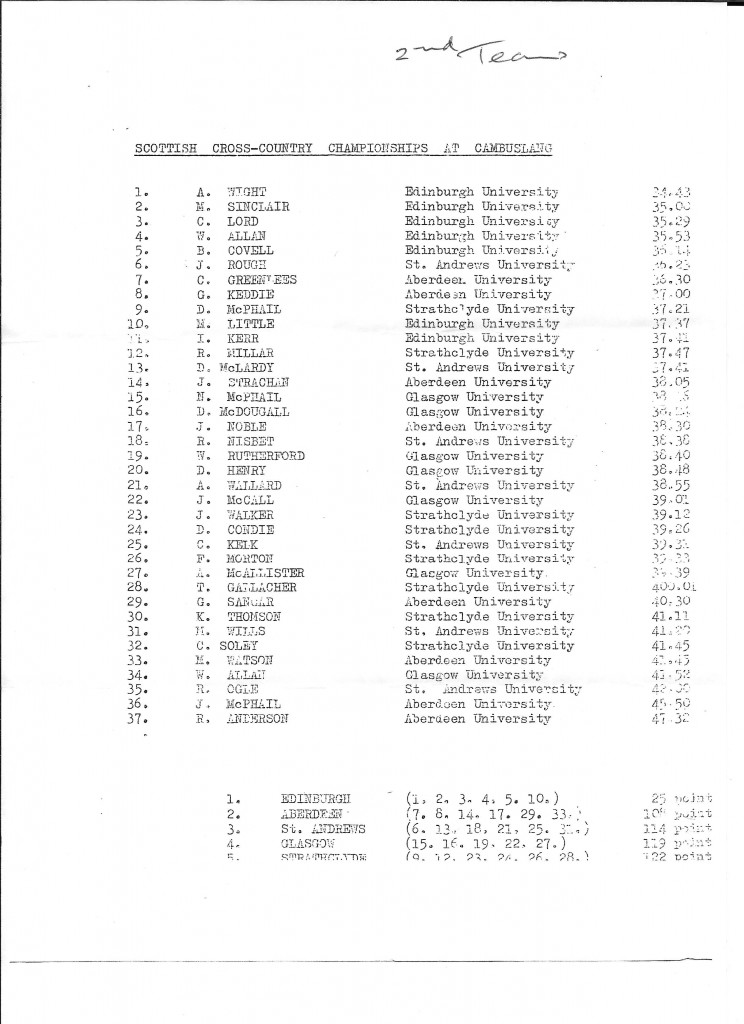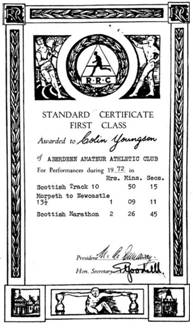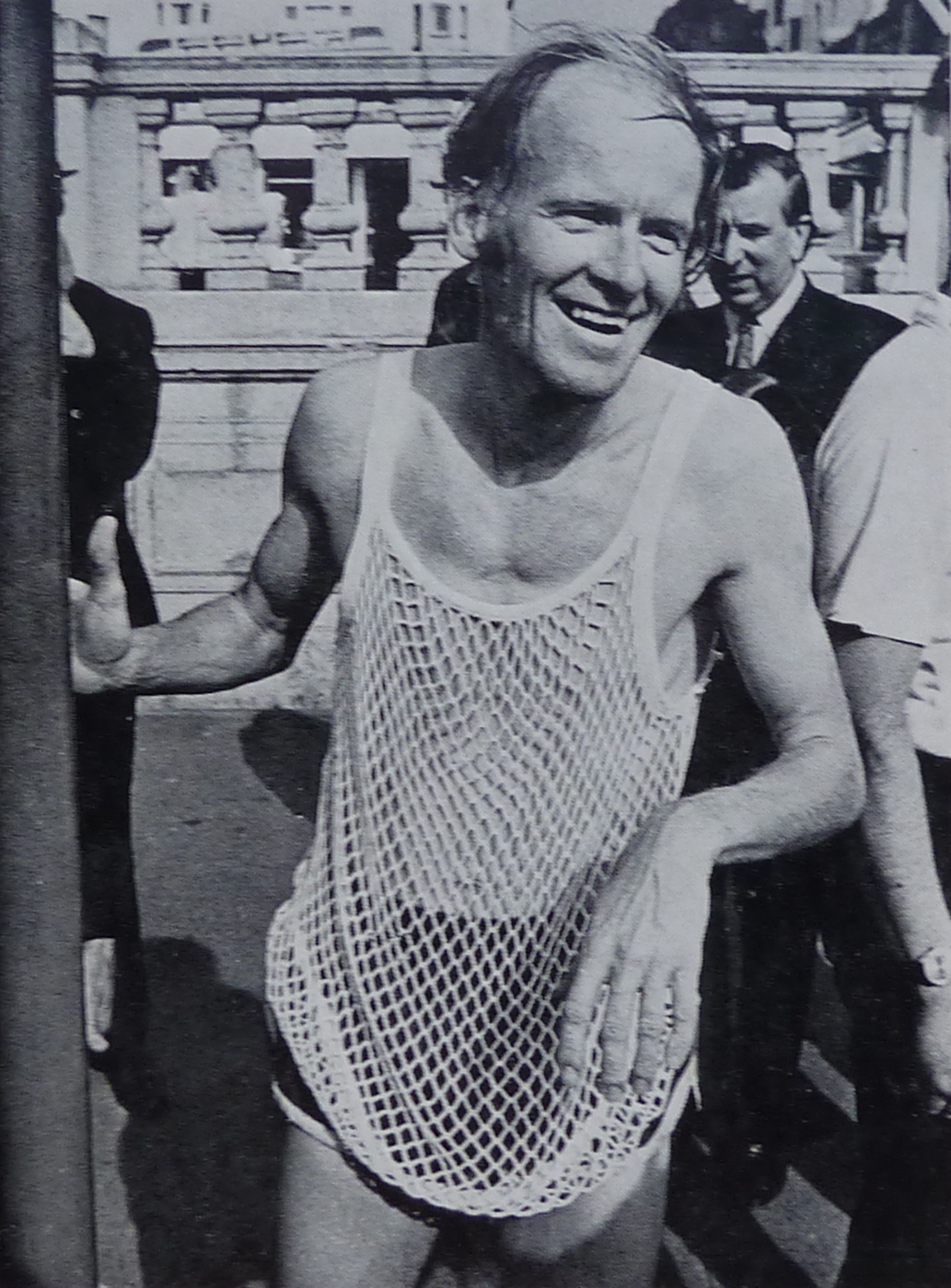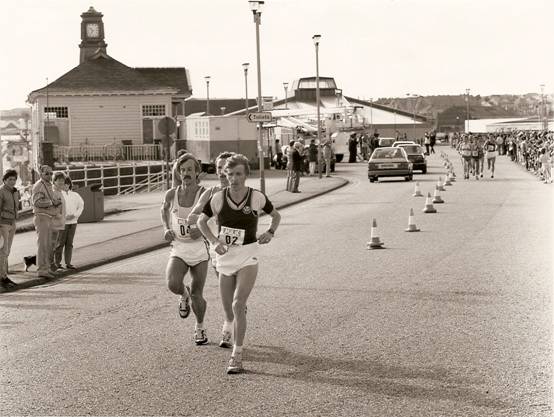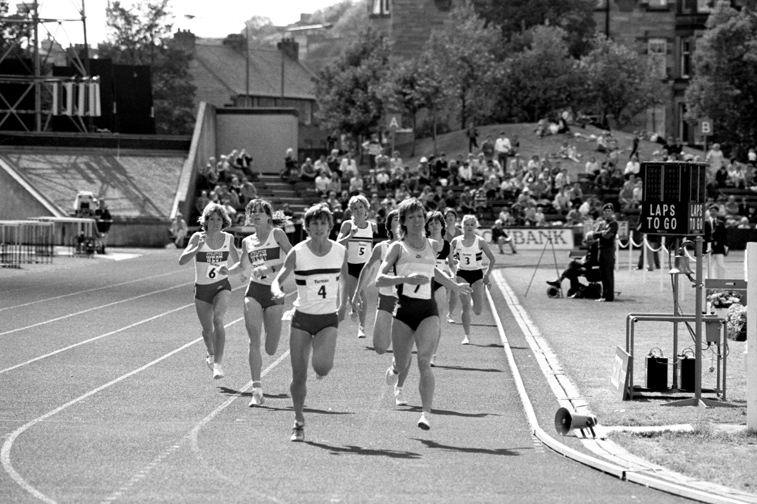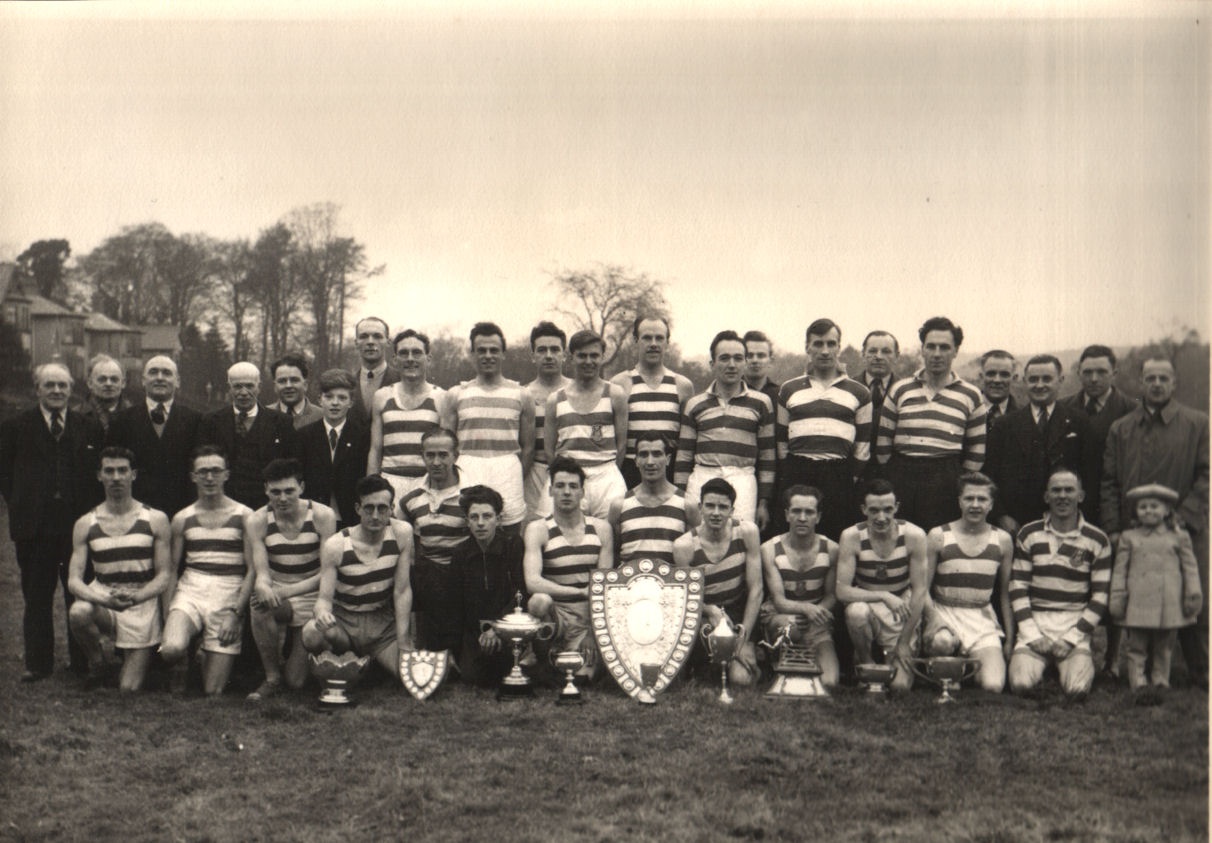
Probably the most successful Scottish club of the 1950’s:
A Victoria Park group taken at Milngavie
1955 was as different from 1975 as chalk from cheese: 1965 was different but there were many similarities and these will probably show up. It was a decade that had an interesting mix – domestic fixtures and also many wonderful international stars appearing in Glasgow and Edinburgh every year at the various ‘Sports’. It was still quite close to the war and the real austerity years so the number of domestic meetings was lower that it would come to be in the 60’s. The Universities played a big part in the athletics of the day with inter-varsity meetings, university sports having open races included, university championships being major meetings in their own right; the various police forces had their meetings – three are mentioned below – with the Glasgow Police meeting in early June being the largest and featuring international stars; and there were the meetings promoted by local factories such as Babcock & Wilcox, Saxone and Singer’s which were regular fixtures. Track Leagues which were a key part of the sport in 1965 had not yet appeared on the scene. Another difference from today, was the coverage given to the ‘Britan v ….’ internationals. The coverage given to meetings such as GBV France, GB v Hungary, GB v Russia and so on with two men per event, (no guest races and very,very seldom was there ever a guest competitor in any of the races) was comprehensive, at times lavish. Maybe surprising when there was seldom more than two or three Scots in the team but it was very soon after the war in which all four British countries had fought side by side and there was no question of us not being British. Anyway, what follows is a snapshot of Scottish athletics in 1955 and it should be compared with 1965 and 1975.
The summer season starts as ever at the end of April and start of May.
On 18th April, Victoria Park competed in the London to Brighton Road Race where they finished ninth with Shettleston sixteenth. Ian Binnie (VP) was third fastest over the seventh stage and Graham Everett (Shettleston) was sixth on the next stage. At home, Cyril O’Boyle (Clydesdale Harriers) won the Balloch to Clydebank 12 miles road race from Alec McDougall (Vale of Leven) in 66:05. The penultimate weekend in April, 1955 was when Glasgow and Edinburgh Universities held their open meetings. At Glasgow the star man was Alan Dunbar in the 100 yards which he won in 10.5 on the grass track at Westerlands, JGR Robertson won the 220 yards in 23.5. The press report noted that Robertson was 6′ 1″ and 14 stone and also won the shot putt with 34′ 5″ as well as finishing second in the 100 yards. JM Finlayson won the mile and three miles in 4:29.2 and 15:38.8 with Peter Ballance second in both. L Barr won the women’s 100 yards (12.7) and 220 yards (29.9). In Edinburgh, at Goldenacre, KA Robertson won the 100 yards in 10.4 seconds, JV Paterson won the 220 yards and the 440 yards in 23.6 seconds and 51 seconds and Adrian Jackson won the mile in 4:18. The big event on 30th April, 1955, was the Victoria Park AAC meeting at Scotstoun. The report read: “A very successful outing for school youths and juniors was held by Victoria Park AAC at Scotstoun Showground on Saturday. The feature of the school events was the fine performance of G Watson of Whitehill Secondary School who, in the 100 yards for boys 15 – 17, clocked 10.6 beating J Craig, John Neilson School, Paisley, by three yards. V Reilly, last year’s Scottish Youth champion, won the Over 17 race in the same time. Both Watson and Reilly returned the same time as did R Quinn who won one of three Victoria Park club races. Quinn beat G Robertson, the Scottish schoolboy champion by half a yard in 10.6 in the club sprint, but over the furlong Robertson beat Quinn by a yard in 23.5 seconds. I Binnie, the holder of records from two miles to one hour’s running, ran in a three mile race and won as he liked in the good time of 14:27.4 beating his nearest rival, J Russell, by over half a lap. Binnie ran the first mile in 4:33, and the second in 4:29. ” Among the other schools winners was CW Fairbrother, John Neilson School, who won the high jump with 5′ 7″.
On the first Saturday in May there were four events, including an attempt by Ian Binnie on the ground record at Meadowbank in an invitation three miles at the Edinburgh Trades Council meeting. He won by almost a lap from Stan Horne of Garscube Harriers in 14:15.3. On the same day, his club defeated Heriot’s FP and Edinburgh Southern Harriers quite comfortably in a triangular fixture at Goldenacre. Results: 100 yards W Breingan (VP) 10.7 sec; 220 yards V Hamilton (VP) 23.8; 440 yards: R Quinn (VP) 50.8; 880 yards D Henson (VP) 1:2:01.8; Mile G Everett (Shettleston) 4:23.6; High Jump W Piper (VP) 6′, equalled ground record; Long Jump T Macnab (S) and G McFarlane (VP) 20′ 8″; Hop, Step and Jump T Macnab (S) 46’8″; Shot J Donnelly (VP) 38′ 02″; Discus J Donnelly (VP) 118′ 6″. Victoria Park also won the 4 x 110 yards relay. The Victoria Park men’s road and cross country team was winning almost everything on the roads and many of the country races at this time, but their track and field team was not too bad either. Meanwhile at Craiglockhart, Edinburgh University was beating a Glasgow University team by 68 points to 50 in the men’s match and 48 to 20 in the women’s. In the B competition between the same two university teams, Edinburgh beat Glasgow 48 to 40.
There were several domestic meetings on 23rd May as well as meetings south of the border with Scots taking part. Glasgow University ‘did not experience any problems’ in beating Aberdeen University at Westerlands despite the absence of several sprinters. In the Mile, where Glasgow’s J Finlayson was expected to give a good account of himself, A Wood of Aberdeen won ‘as he pleased’. In the Bonnybridge meeting, Miss J Herman ran a very good 200 yards in 27.4 seconds despite the ground conditions, Willie Drysdale of Monkland won the men’s mile in 4:27. Edinburgh University defeated Stewart’s College at Craiglockhart and Clydesdale Harriers was the strongest club in the ne Dunbartonshire Championships with the two best performances of the day – by WS Linton (ex-Braidburn) in the 880 yards in 2:01.5, and John Hume in the 440 yards in 53.7 seconds. Other winners were George Rodger (Clydesdale in the 100 yards) in 10.8, Bob Steele (Vale of Leven) in the 220 yards in 24.4, Stan Horne of Garscube in the Mile in 4:34.4, Gordon Dickson, also Garscube, in the Three Miles in 15:26. Looking at that group, we note that Dickson moved to Victoria Park for several years before going back to Garscube, Bob Steele moved to Edinburgh, joined Edinburgh Southern Harriers and became administrator for the Scottish endurance squad and Willie Drysdale is still running in 2014 as a veteran, albeit for Law & District. Ian Binnie ran at the Caledonian Games at the White City where he set the pace for the first mile before fading and finishing down the field.
On 28th May, Alan Gordon finished fourth and just outside four minutes for the Mile at White City. In the Glasgow University championships, JGR Robertson defeated Alan Dunbar in both 100 and 220 yards in 10 sec and 22.5 seconds. His 100 yards time was new ground record but at the Edinburgh University championships a new Scottish native record for the javelin was set by DWR McKenzie with a throw of 214′ 11″ but the athlete of the meeting was JV Paterson. Paterson ran 50.3 seconds for the 440 yards and a half mile record of 1:57.8. Adrian Jackson won the Three Miles in 14:58.9, considerably quicker than the Glasgow equivalent.
Athletics attention was firmly on the Glasgow Police International Athletic Gathering – the 72nd of the series – on 5th June, 1955. Athletes from Scotland, England, Norway, Sweden, Holland, Belgium and Switzerland were all there providing good competition for the athletes, excitement beyond the ordinary for the spectators and good publicity for the sport. The report:
“High winds affected performances at the 72nd Glasgow Police International Athletic Gathering on Saturday at Ibrox Stadium, where the attendance was below expectations. Two records were accomplished – both in one race, the three miles. R Dunkley, a former outstanding AAA’s Junior miler, made a superb last lap effort to beat the Scottish champion, I Binnie (Victoria Park), by 30 yards in the new all-comers record time of 13:50.3 – some 4 seconds better than the previous record of F Mihalic (Yugoslavia) at the Glasgow Highland Gathering last year. Binnie clocked 13:54.8, a new Scottish native record. Binnie in his customary manner set the pace for the field of seven entrants. Before he reached the two mile mark he held a lead of 80 yards, clocking 4:31.4 for the first mile, and 9:12.4 for the second. F Herman (Belgium) lay second, closely followed by Dunkley. Just before the last lap the Englishman left Herman, cut down Binnie’s lead by the bell to 40 yards, and sped past him a furlong from the finish. Binnie, as he himself said afterwards, had no answer to the effort.
The other chief features were the win of AS Dunbar (Glasgow University and Victoria Park) in the special 100 yards, in which he beat Continental and English opposition in the fine time of 10.1 seconds, and the brilliant running of W Henderson (Watsonians) in the furlong for neither J Carlsson (Sweden) nor W Ferguson (AAA’s) could hold the Edinburgh sprinter who had to make all his own running in the outside lane. He clocked 22.3 seconds and wn by a yard and a half.
Local athletes achieved results better than normal. In the open high jump W Piper (Glasgow Police) with a half inch allowance cleared 6′ 3″ – a fine feat in the conditions. R Quinn (Victoria Park) won the open 220 yards from the back mark of one yard in 22.5 seconds – one of his best achievements. G Everett (Shettleston Harriers), a former Hutchesons Grammar School boy, won the open ‘half’ as he liked in 1:55.9. He should be seen to advantage in the coming national Mile championship at New Meadowbank.”
Results of invitation events:
100 yards: 1. AS Dunbar 10.1; 2. J Carlsson (Sweden); 3. W Ferguson (AAA’a). 220 yards: 1. W Henderson 22.3; 2. W Ferguson; 3. J Carlsson
440 yards: 1. FP Higgins (AAA) 50.2; 2. JJ Hogg (Switzerland); 3. H de Kroon (Holland). 880 yards: A Boysen) Norway 1:53.7; 2. DCE Gorrie (AAA’s); 3. RD Henderson (AAA’s).
Mile: 1. J Ericsson (Sweden) 4:13.3; 2. J Disley (AAA’s); 3. FL Wyatt(AAA’s). Three Miles: R Dunkley (AAA’s) 13:50.3; 2. I Binnie (VPAAC); 3. F Hermann.
440 yards hurdles: 1. TS Farrell (AAA’s) 53.8; 2. H Kane (AAA’s); 3. PB Hildreth (AAA’s). Pole Vault: 1. R Lundberg (Sweden) 13′ 3″; 2. NGA Gregor (AAA’s); 3. R Petitjean (AAA’s).
There were also 7 senior events, 3 youth events and, of course, three events confined to the police.
The Scottish Universities Championships at Westerlands were also taking place that afternoon and Edinburgh was the top dog there. JGR Robertson won the 100 and 220 yards but had some wind assistance when he recorded 10 seconds for the 100. JV Paterson won the 440in 51.4, AS Jackson the three miles in 15:11.8. CAR Dennis of Edinburgh won both hurdles races in 15.5 and 59.3 seconds, and also won the discus ith just over 109 feet.
Seven days later, 12th June, and the big British event was Oxford and Cambridge v Harvard and Yale at the White City. But back at home in Scotland, another University fixture caught the headlines – Atalanta (a Scottish universities select team) was competing against the Christie Club (Leeds, Liverpool and Manchester Universities) and won by 60 pts to 45. The top results were in the throws where Mark Pharaoh’s discus throw for Christie) and ECK Douglas of Atalanta’s hammer were better than their English counterparts. Pharaoh’s discus was 160′ 9.5″ and Douglas’s hammer effort was 176′ 2″ to set a new ground record. DWR Mackenzie threw the javelin 199′ 10″ which was also a ground record. JV Paterson set a new record for the 440 yards with his run of 50.1 seconds. RJ Beecroft (Christie) also set a new ground record – in the Mile with 4:15.1. A Wood of Atalanta who was third ran anew personal best of 4:16. The SWAAA Championhips were also held on that afternoon and the best results were by Pat Devine, just up from London, who won three events – the 100 yards (11.8), 220 yards (26.4) and the long jump (17′ 11″). Aileen Drummond (later Lusk) of Maryhill Harriers also won two events – the 880 yards (2:30.8) and the mile (5:42.3). There were also meetings at Motherwell & Wishaw and Madderty in Perthshire. The annual Goatfell Race was also decided: Stan Horne of Garscube defeated Pat Moy of Vale of Leven and Gordon Dickson of Garscube. The winner’s time took 10 minutes from the record and the first five finishers were all inside the previous record.
On Saturday, 18th June, the headlines were all about a meeting at the White City in which no Scots appeared to be taking part – this was not uncommon as the reports tended to start with the biggest meeting and make their way down the page to a three line report on a wee local meeting. Below that came the Scottish Schools Boys championship and Scottish Schools Girls championship held respectively at Goldenacre and Westerlands. The girls event trophy for the performance of the meeting, the Frances Barker Shield, went to M Bain (Aberdeen Grammar School) whose time for the 80 metres hurdles was 12.3 seconds which was only one tenth outside the Scottish native record. She also equalled the high jump record with 4′ 11″ but finished second in that event to another Aberdeen girl, P Bellamy (Albyn), who created a new meeting record of 5′ 0″. Aberdeen High School also won the Paisley Shields for most points. These trophies for a points aggregate were not uncommon at the time and were a variation on specific inter-club fixtures for such awards. There were only two age groups at the boys championships – 15 to 17, and 17to 19 but there were eleven new meeting records set. The name most familiar to the present generation ius that of Crawford Fairbrother (John Neilsons) who added 2.25″ to the high jump record by clearing 5′ 10″. At the time the feat of the day was the pole vault record of 11′ 3.25″ by PB Hall of Fettes. The 100 yards was won in 10 seconds flat by E McKeating, the Heriot’s cricket and athletics captain.
In the Lanarkshire Police Sports at Shawfield, home of Clyde FC, JGR Robertson of Glasgow University won the 100 yards handicap from one and a half yards in 9.8 although he only just made the final with 9.9 against Victoria Park clubmate J Semple by a foot. TA Logan (Renfrew and Bute Police) won the shot with 46′ 1.25″ but the ball was found to be at least a pound short of 16 pounds and so it could not be a record. Among the other results was John Stevenson (Greenock Wellpark) winning the two miles with 9:25.9, Victoria Park won the team race, W Piper (Glasgow Police with a half inch allowance in the high jump) winning his event with 6′ 1.5″. This meeting clashed with the Babcock & Wilcox meeting at Renfrew and both suffered slightly in consequence but there was good sport there too with AS McManus of the host club winning the 220 yards in 22.4 off 7 yards and Bill Black of Maryhill off 15 yards winning the mile in 4:17.6. J Campbell of Paisley won the 14 mile road race in 1:28:29. The Empire Exhibition Trophy for the team with most points over seven named events went to Clydesdale Harriers whose medley relay team of John Hume, George Rodger, Willie McDonald and Bill Linton won the invitation event. Robert Clark was substituted for Willie MacDonald and the team won the SAAA 4 x 400 championship later that year.

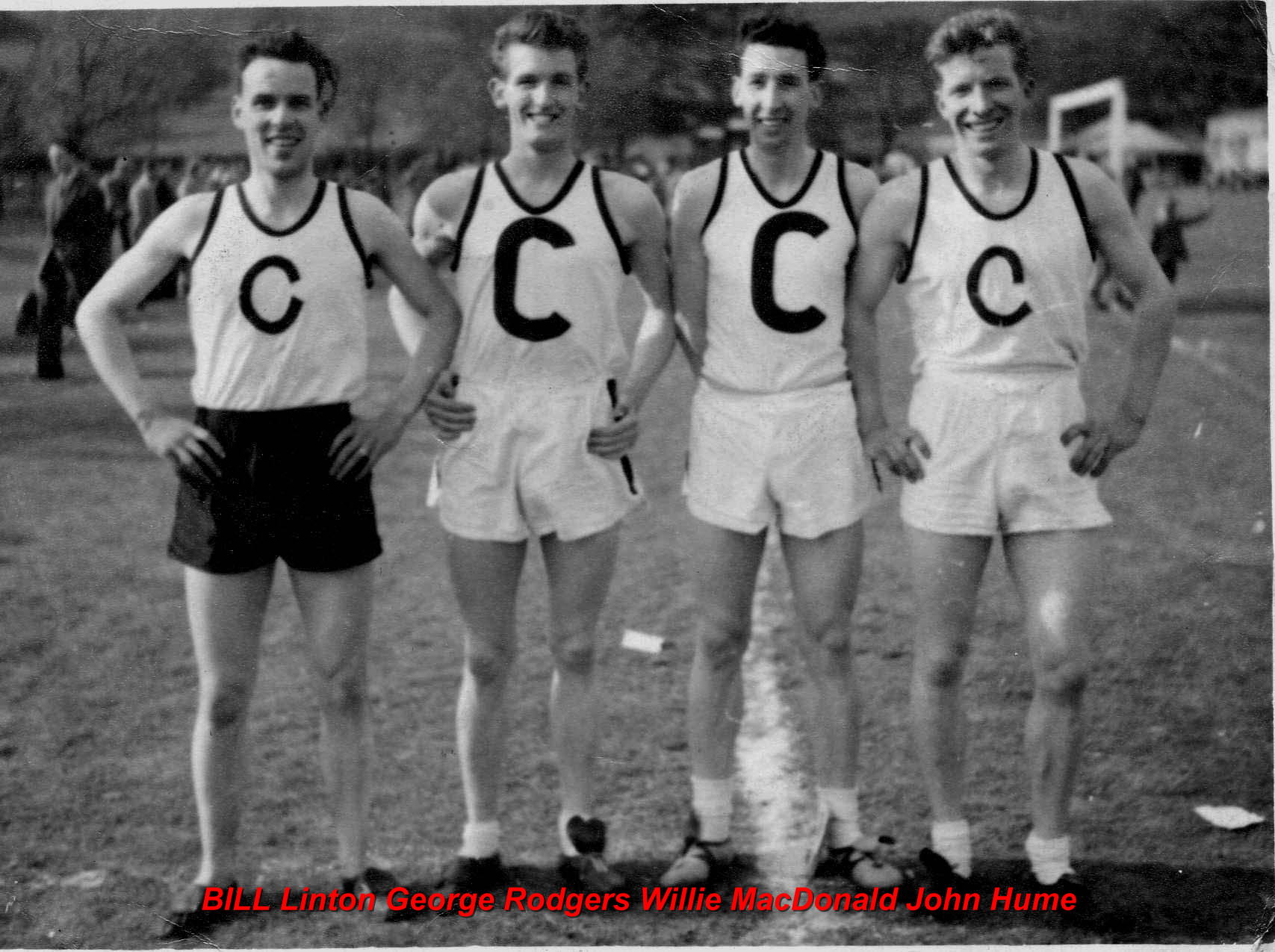
The Clydesdale Relay Team
The SAAA Championships were held on 25th June – the last Saturday in June being the traditional date for the fixture, everyone knew what the peak of the season would be and could prepare for it. The report was headlined McGHEE’S FINE PERFORMANCE IN THE MARATHON” and went on
“In the Scottish Amateur Athletic Association’s sixty third annual championship meeting at New Meadowbank on Friday and Saturday, 13 competitors retained their titles and there were nine new champions. The drawings for the meeting were up by as much as £200. Three double event winners emerged – I Binnie (Victoria Park) won won the three and six miles, CF Riach (Jordanhill Training College) who won the discus and javelin, and CAR Dennis (Edinburgh University) who won the 120 and 440 yards hurdles.
Without doubt the performance of the meeting was achieved in the gruelling marathon race in which Empire Games champion J McGhee (Shettleston Harriers) outstripped his rivals and won in the new championship best time of 2:25:50. He beat GC King (Wellpark Harriers) by about one and a half miles in a race which he controlled from the start. Although the award of the Crabbie Cup is in abeyance, it is clear that McGhee has an excellent chance of winning the award. As many as 15 of the 18 who finished the marathon received standards all of them finishing within three hours for the testing course. They were however favoured by a following wind.
Five runners finished within 4:21 for the mile on a track that was not in the best condition for fast times. In addition the wind was a handicap. The performance of GE Everett (Shettleston Harriers) in beating AS Jackson (Edinburgh University), the holder, by 15 yards in the fine time of 4:13.2 suggests that we have a fine miler capable of distinguishing himself in better company. His judgement was beyond reproach for he contented himself with remaining within easy reach of the leaders until 300 yards from the finish and then finished so strongly that the holder could not cope with him. The most thrilling race of the afternoon was the quarter mile . The favourite, JV Paterson (Edinburgh University) who had a distinct advantage on entering the home straight, found R Quinn (Victoria Park) alongside him on the finishing line and the latter’s determined effort succeeded by inches in the good time of 49.6 seconds.
The defeat of DWR McKenzie in the javelin was the surprise of the field events. On many occasions he has beaten his latest 187′ 4.5″. “
That’s where the report ends – not a mention of Fraser Riach’s throw of 189′ 9″ which won the event! It was the tradition until fairly recently that no permits were issued on the days of Scottish championships – track & field of cross-country – and it meant bigger entries and usually more spectators.
“Conditions at Westerlands are rarely ever ideal for athletics, and Saturday was no exception on the occasion of the Scottish junior and youth championships.” was the first sentence of the report in the Glasgow Herald of 4th July. The meeting incorporated the SAAA 4 x 440 yards relay championship and the Clydesdale Harriers squad of Linton, Rodger, Clark and Hume beat the favourites, Victoria Park, in 3:28 with Shettleston Harriers separating them in second.. So convinced was one of the Glasgow papers that their photographer took a picture, which was published, of Bobby Quinn finishing as one of the victorious team. In the championship itself, top performance was RR McDonald (Heriot’s) in the half mile where he set a new record of 2:05.3 and A Hannah (Athenians and Preston Lodge) set a new 220 yards hurdles record of 24.2 seconds defeating WG Montgomery (Cambuslang Harriers) who had just equalled the record when winning the 120 yards hurdles in 15.8 seconds. At Stevenston in Ayrshire at the Ardeer Sports Club event Tommy Mercer (Bellahouston) won the handicap half mile off 38 yards in 1:56.8, and Molly Ferguson (later Wilmoth) won the women’s 220 yards off 9 yards in 28.5.
Many of the Sports meetings at this time were sponsored by local businesses – Babcock’s has already been mentioned – and the Saxone shoe company had a meeting at Kilmarnock called the Saxone Welfare Association Sports in the second weekend in July. The competitors were mostly from local clubs such as Beith, Muirkirk and Irvine but there were athletes from wider afield including a sprinter from Belfast, T Mills of 9th Old Boys, who won the 100 yards. The professional Border Games was also being held and the outstanding talent was Mike Glen from Bathgate who won the Two Miles Handicap – but there were 28 heats of the £200 Jedforest 120 yards handicap. Back among the amateurs Joe McGhee repeated his win over George King in the 12 mile road race at the Dundee North End Sports in a record 1:06:24. On the track top athlete was Miss P Bellamy (Aberdeen Amateurs) who won the 100 (off 7 yards, 11.3) and 220 yards (13 yards, 25.9).

CHAMPIONSHIP RECORD BY SCOTTISH JUNIOR RELAY TEAM
Though the victories by BS Hewson and CJ Chataway, two of England’s four-minute milers, in the mile and four mile events received the greatest applause at the AAA’s Championships at the White City, London, on Saturday, there was no more impressive success than that of the Victoria Park AAC who won the junior 440 yards relay title in new record time of 43.8. V Reilly, one of five athletic sons of a well-known Glasgow medical family, laid the foundation of the victory with a splendid first “leg”, and D Struthers, W Burns and R Beaton carried on the good work. I suggest however that no one did more to win the title than and gain the record than the one who trained those boys in baton changing. They were well practiced and confident. Shettleston Harriers won the event two years ago and it seems as if Scotland have the youngsters to uphold their prestige in the future.
The small Scottish representation won two more titles at the meeting, the others being the hammer and the high jump. Dr ECK Douglas won the hammer throw on Friday night, and a Glasgow police constable, W Piper, won the high jump on Saturday. He cleared 6′ 3″ as did O Okuwobi (Cambridge University) but the Scot, who won a AAA junior title, the pole vault, in 1949, had fewer failures at lesser heights. Piper has established himself as first choice for the British teams who have matches against Germany and Hungary and a visit to Moscow this year. …. “
After Glasgow and Lanarkshire, the Edinburgh Police had their sports on this Saturday – 16th July – too. Held at Meadowbank, Edinburgh Southern Harriers won the SWAAA 4 x 110 yards relay title, while Clydesdale Harriers won the men’s invitation medley relay. Top athlete in a purely domestic field was Mrs JG Herman who was only 0.2 seconds outside the Scottish record when winning the 440 yards 58.5 seconds. In the North, Alastair Wood set anew north record for the two miles at Forres Highland Games taking 12 seconds from the old record. Unfortunately the winning time was not included in the report of the meeting. There were six starters in the 15 miles organised by the Broughty Ferry and District Development Association’s Sports, half of them dropped out and George King won the event in 1:39.04.
On 23rd July at the Aberdeen Corporation Sports at the Linksfield Stadium, JV Paterson equalled the Scottish half mile record when he won the event in 1:53.6. Paterson and Bobby Quinn (VPAAC) were both off scratch in the 440 yards but Quinn won in 49.5 seconds with Paterson finishing third behind D Martineau (Aberdeen). Piper was in the news too when he won the British Police high jump (6′ 5.5″) and pole vault (11′ 6″) at their championships at Liverpool. There were six Scottish victories at the event. The 100 yards was won by A Stewart (Lanarkshire) in 10.6, the shot TA Logan (Renfrew and Bute) with 44′ 6″, the long jump by AM Law (Renfrewshire) with 21′ 1″ and Miss I Plenderleith (Edinburgh City won the 100 yards in 12.3 seconds.
There were also meetings at Elgin and Lochearnhead but the junior men again distinguished themselves at the AAA Junior Championships at Reading. E McKeating of Heriot’s took first place in the 100 yards in 10 seconds, and A Hannah (Preston Lodge) won the 220 yards hurdles in 23.4seconds. There had been doubts raised at the quality of the time keeping or course measurement after he ran 24.2 seconds at the Scottish Schools meeting, but this time was eight tenths quicker so putting all doubts to rest.
Piper’s reward was not long in coming – the next week on Saturday 30th July he competed at White City the following week and defeated the German W Puell with a clearance of 6′ 4″ at his second attempt, Puell needed three. There were comments that Piper had started to jump wearing just one shoe, ‘a technique that is becoming more popular with British High Jumpers.’ At home there was another football club involved in the promotion of athletics – a joint Falkirk FC/Falkirk Victoria Harriers meeting at Brockville produced a two mile record from Alex Breckenridge (Victoria Park) – but then it was discovered that the course was short and the time, which came out of an intense duel with Graham Everett, could not be recognised. The course was a lap short – I remember the same thing happening at Brockville when I ran there several years later – the lap had to be short to fit the space available and all distance races had more laps than elsewhere. At this meeting there was some good athletics, though. Neil Donachie (Braidburn) won the 880 yards off 10 yards in 1:56.3; Jim Irvine of Bellahouston won the Mile in 4:15.3 off 140 yards. Among the professionals, Jay Scott won eight events at Dingwall – what a sportsman he was.
… and on the first Saturday in August it was, as ever, the Rangers Sports at Ibrox.
GREAT HALF MILE RACE AT IBROX STADIUM
Two New Middle Distance Records
Rangers Football Club have every reason to be pleased with their 69th annual sports meeting at Ibrox Stadium on Saturday when a crowd of 50,000 saw several splendid races, two of which – the half-mile and mile – produced new Scottish all-comers records.
Never has so brilliant a half-mile been run in Scotland – eight yards covering the first four three of whom returned times inside the previous all-comers record of 1:50. T Courtney (USA), BS Hewson (AAA) and DJN Johnstone (AAA) and A Boysen (Norway) have all been in record breaking form in recent years, so when the first lap with S Oseid (Norway) in the lead ended in 52.8 seconds and Boysen, holder of the record, went to the front a stirring finish was inevitable. Only over the last 30 yards did Courtney gain the lead and despite determined efforts by Hewson and Johnson, the American held on and won by half a yard in the marvellous time of 1:49.2. His performance is rated even better than the time indicates, for a troublesome wind faced the runners in the finishing straight and the track was very loose – factors that may well have added two seconds to the time and deprived Courtney of a world record.
A 2:20 first half almost ruled out the prospect of a mile record until the native record holder, AD Breckenridge (Victoria Park), shot to the front. but what a race developed round the last lap. Neither Seaman (USA) nor Ken Wood (AAA), however, could hold the easy-running G Nielson (Denmark) who beat Wood by five yards in the new all-comers record of 4:08.9. Had this race been run differently, two or three more seconds would have been lopped off. R Blair (USA) was a commanding figure in the 120 yards short limit handicap. He won the final splendidly yet had little to spare for B Shenton (AAA), often guilty of beating the gun, was very quickly off his mark, so the big American had to pull out something special over the last 20 yards to win. His time of 11.4beat the all-comers record but it cannot be recognised because the following wind was well over the permitted maximum. Blair also won one of the special 220 yards races in 21.8, 0.9 sec over his best time for the distance. In the 220 yards hurdles race, PB Hildreth returned 24.3 sec – only 0.2 sec worse than his own British record established at the White City, London, four years ago.
Results of Invitation Events
| Event |
First |
Performance |
Second |
Third |
| 120y |
R Blair (USA) |
11.4 seconds |
B Shenton (AAA) |
EK Sandstrom (AAA) |
| 220y 1st race |
R Blair (USA) |
21.8 seconds |
E Sandstrom |
W Henderson (Watsonians) |
| 220y 2nd race |
MJ Ruddy (AAA) |
22.0 seconds |
B Shenton |
AS Dunbar (Victoria Park) |
| 440y |
MG Wheeler (AAA) |
48.8 seconds |
A Christiansen (Denmark) |
P Higgins (AAA) |
| 880y |
T Courtney (USA) |
1:49.2 |
BS Hewson (AAA) |
DJN Johnstone (AAA) |
| Mile |
G Nielson (Denmark) |
4:8.9 |
K Wood (AAA) |
D Seaman (USA) |
| Two Miles |
DJ Ibbotson (AAA) |
8:56.2 |
BT Barrett (AAA) |
P Driver (AAA) |
| 220y hurdles |
PB Hildreth (AAA) |
24.3 |
RD Shaw (AAA) |
PAL Vine (AAA) |
| One Hour Run |
G King (Greenock Wellpark) |
10 miles 1625 yards |
H Fox (Shettleston) |
D Clelland (Falkirk Victoria) |
| Pole Vault |
I Ward (AAA) |
13′ 4″ |
G Schmidt (AAA) |
G Breed (AAA) |
| 4 x 440y relay |
AAA |
3:19.8 |
Scandinavia |
|
There were also eight open handicap events, two cycle races and the inevitable five-a-side where Hibernian lost to Celtic 2-0 in the final, goals scored by Fernie and Peacock.
There were no other amateur events on in Scotland on that particular day although there were a couple of professional meetings.
There was another major meeting at the White City just one week later – the GB v Hungary match which Hungary won comfortably. ECK Douglas was the only Scot in action on the Saturday and was placed third (first Briton) with a hammer throw of 181′ 11″ behind Czermak’s 193′ 2″. There were several disappointing runs by British runners – Chataway (2nd) and Ibbotson (4th) were beaten by Tabori in the Three Milles where he won in 13:44.6. Chataway had the same time but the judges gave the verdict to the Hungarian. Brian Hewson won the 880 yards from Szentgali and Roszavolgyi in 1:48.6 which was a British all-comers record, and John Disley and Eric Shirley had a 1-2 in the steeplechase with the winning time being 8:55.4.
Back in Scotland DWR MacKenzie (Edinburgh University won the javelin contest at Nairn Games with a new ground record of 200′ 5.25″. There was also a professional meeting at Taynuilt in Argyll where the highlight was new high record set by Jay Scott of Inchmurrin – he also won the pole vault and long jump. But there was no shortage of action the following week when Edinburgh Highland Games brought a touch of international athletics back to the domestic scene.
Just two weeks after the Rangers Sports, we now had England, Belgium, Luxemburg, Australia, South Africa, Eire and Switzerland sharing Murrayfield with Scottish handicap racers. The report read:
“Two all-comers records were broken and one equalled at the ninth Edinburgh Highland Games at Murrayfield on Saturday. The new all-comers records were achieved by K Wood (AAA) with 4:08.8 in the Mile, and Miss T Hopkins (Queen’s University, Belfast) with 5′ 6” in the high jump. The equalled all-comers record was 25.1 sec for the furlong by Miss M Francis (AAA) the British record holder for the 100 yards. The Games records were of course broken in these events and other Games records were achieved in the marathon, inter-city relay, 220 yards and Two Miles. E Kirkup (AAA) won the marathon in 2:31:03 – 7 minutes better than the previous best of the late Donald Robertson four years ago. J McGhee retired at 15 miles. He has not fully recovered from an injured foot.
Wood had a runaway win in the Mile. He was content to lie behind the pace maker, AD Breckenridge, but entering the last lap he never gave his rivals a chance to get on terms with him. His time was one second better than G Nielson at Ibrox Stadium which is awaiting approval. Miss Hopkins was an easy winner, beating the present all-comers record in the high jump of D Walby (Glasgow University) by 4 inches. She attempted 5′ 8.5″ , hopeful of beating the world record but failed. The best race of the day was the two miles in which P Driver and BT Barrett fought out a terrific last lap, the latter losing by a yard in the good time of 8:57.7. The Scottish champion I Binnie tried to keep with the leaders but he evidently cannot cope with the powerful finishes of the English runners.”
Results of invitation Events: Men Page 4!
| Event |
Winner |
Performance |
Second |
Third |
| 100 yards |
ER Sandstrom (AAA) |
10 seconds |
B Shenton (AAA) |
J Vercruysse (Belgium) |
| 220 yards |
B Shenton |
21.9 seconds* |
W Henderson (Benwell) |
ER Sandstrom |
| 440 yards |
PG Fryer (AAA) |
49.1 seconds |
S Steger (Switzerland) |
R Quinn (VPAAC) |
| 880 yards |
M Farrell (Midland Counties |
1:56.3 |
N Donachie (Braidburn) |
J Douglas (Australia) |
| One Mile |
K Wood (AAA) |
4:08.8 |
JS Evans (AAA) |
R Muller (Luxemburg) |
| Two Miles |
P Driver (AAA) |
8:57.7 |
BT Barrett (AAA) |
AH Brown (Motherwell) |
| Marathon |
E Kirkup (Rotherham) |
2:31:03* |
J Mekler (South Africa) |
GW King (Greenock Wellpark) |
| High Jump |
W Piper (Glasgow Police) |
6’4″ |
C Vandyck (London) |
W Herssens (Belgium) |
| Pole Vault |
I Ward (AAA) |
13′ |
V McCann (AAU of Eire) |
PW Milligan (Victoria Park) |
| Shot Putt |
E Van de Zande (Belgium) |
48′ 10.5″ |
J Drummond (SAAA) |
AR Valentine (SAAA) |
| Hammer (Scots) |
AR Valentine |
107′ |
W Ross (SAAA) |
S Baker (SAAA) |
| Inter association relay (1408 yards) |
English AAA |
2:42.2 |
Scottish AAA** |
Eire |
| Inter city relay (1408 yards |
Birmingham |
2:43.2* |
Glasgow*** |
|
* Games Record ** Scots team was DC Gorrie, JG Robertson, W Henderson, R Quinn *** Glasgow team was D McDonald, JG Robertson, R Quinn, R Stoddart
Women
| Event |
Winner |
Performance |
Second |
Third |
| 100 yards |
H Hermitage (WAAA) |
11.1 |
J Loftus (WAAA) |
P Devine (WAAA) |
| 220 yards |
M Francis (WAAA) |
25.1* |
M Fenton (WAAA) |
P Devine (WAAA) |
| 80m hurdles |
M Francis (WAAA) |
11.4 |
T Hopkins (Queen’s University, Belfast) |
P Wainwright (Airedale) |
| High Jump |
T Hopkins** |
5′ 6″ |
P Robson (Salford) |
P Bellamy (Aberdeen AAA) |
* Equals Games Record ** All Comers Record
It really was an excellent meeting – an attempt on a world record, Scots ‘interfering’ in contests between world ranked athletes (Bobby Quinn in the quarter mile, Neil Donachie in the 880, Andy Brown in the two miles, Peter Milligan in the pole vault) – even beating them (Piper in the high jump), men and women competing before a big crowd and it all happened at home in Scotland! Something that will probably never ever be reprised.
The other big (-ish) meeting that day was the Bute Highland Games at Rothesay where Miss JDM Webster from Leith set a new Scottish record in the women’s mile. She recorded a time of 2:23.4. U O’Connor of Eire cleared 11′ 6″ in the pole vault for a new ground record and TD Logan (Glasgow Police) broke the ground record for the shot putt with 45′ 9″while, having a very good year, the Clydesdale Harriers team won the relay. Clubs represented among the event winners were Bute Shinty AC, Ardeer Recreation Club, West Kilbride, Inverness Burgh Police, Lanark Constabulary and Glasgow Police – as well, of course, as Shettleston, Victoria Park, Bellahouston, Wellpark and Clydesdale of the more traditional clubs. Jay Scott won six events at Abernethy Highlanders Games, St Ronan’s Games were held at Innerleithen and Glenfinnan Highland Games attracted a crowd of over 2000. It would have been interesting to have seen Jay Scott at Murrayfield, would it not?
There were always two trips down the Clyde at the end of August. Rothesay was first, then at the very end of the month – Cowal. The biggest crowd of the summer outside of the Rangers Sports and Edinburgh Highland Games and except for the Throws an almost entirely domestic field. In 1955 the top man was high jumper W Piper, the AAA High Jump champion in the handicap competition. Conceding generous starts to the opposition he cleared 6′ 6″ which was a personal best and equalled the four year old record set by Alan Paterson. “Encouraged by that effort Piper then attempted to clear 6′ 7.5″ and beat the native and all-comers record held by Paterson. One of three jumps went very near to clearing the height but his elbow brought down the lathe.” There were only two invitation events – the 880 yards for men and the 440 yards for women. In the former R Boyd of Glasgow University ran the first quarter in 56.8 and at the finish had won in 1:55.0 but failed by only 0.7 seconds to beat the record held by Donald Gorrie. R Stoddart of Bellahouston was second and Bill Linton of Clydesdale third. In the women’s race, which was specially arranged for Miss J Herman (Edinburgh Southern Harriers) she found that Pat Devine of Dundee’s Q Club too good for her. Devine, best known as a sprinter had gone to live in London for a time to improve her athletics and had run for the WAAA at Edinburgh, won in 58.5 seconds – 0.2 outside the record held by Hermen who was beaten by several yards. It was also on that weekend that it was announced that there would be a combined East and West German team for the 1956 Olympics with the only real point of discussion being which anthem to use!
That just about finished the summer’s athletics. Piper was in action in both of the following two weeks for Britain – one week later against France in London where he equalled the winning height (6′ 3″)but had to take second on countback, and two weeks later against Russia in Moscow where he was third after clearing 6′ 2.75″. ECK Douglas was fourth in the hammer in Moscow.
At home it was the Shotts Highland Games on 3rd September where Graham Everett and Alex Breckenridge had a tremendous duel in the two miles before Breckenridge won in 9:33 leading his club to victory in the team contest. Andy Brown (with a ‘rather generous allowance of 50 yards’) won the invitation mile from Alastair Wood who had foregone his handicap of 20 yards to run from scratch. He justified the decision and was third at the end in 4:22.2 – not at all bad on the Shotts track with the downhill back straight and uphill home straight! . The Ben Nevis race was won by Eddie Campbell of Lochaber for the third time in four years in 1:50:05. “Miss Kathleen Connochie, aged 16, the daughter of a Fort William doctor was debarred by the SAAA because of her age, but she made the run unofficially and was awarded a special prize.” On 10th September it was the popular Dunblane Highland Games held on a grass track in a natural amphitheatre with fairly high grass banks for the spectators on the home straight and first bend. Joe McGhee won the 14 mile road race in a new record time of 1:12:14 with George King and Hugo King both inside the old record as well. Andy Brown gained his third mile race in as many competitions, this time off 45 yards, Joe Connolly won the 880 yards, and the sprints went to Breingan (VPAAC – 100 yards off two and a half in 10.2) and W Reville (Shettleston off 13 in 24 seconds). The Pitlochry Games were also held with S Hogg (Cardenden) winning three events. The final road race of the season before the cross-country and road running fixtures took over was the Scottish Marathon Club’s 20 miles event at Cambuslang. Joe McGhee won in 1:45:09. Hugo Fox was second (1:450:15), George King third (1:50:36), David Bowman (Clydesdale) fourth (1:59:02), T Phelan (Springburn) fifth 1:59:59) and Bob Donald (Garscube) sixth (2:05:14).
And so the season finished. After the regular start with County and District championships at the end of April and May, interspersed with University fixtures and open meetings, the summer came to life with the Glasgow Police Sports and then the SAAA Championships, and accelerated even further in July and August with the ‘biggies’ being the Rangers Sports and Edinburgh Highland Games where the greats of the sport shared the track with club and university athletes, before ending with the Highland Games at Bute, Cowal, Shotts and Dunblane. To some of us, it was maybe the best decade for Scottish athletics – we all had agood conceith of ourselves, not an arrogance but a confidence and knowledge of our place in the sport and the place of the sport in our lives in general.
